SVA test 1
1/15
There's no tags or description
Looks like no tags are added yet.
Name | Mastery | Learn | Test | Matching | Spaced |
|---|
No study sessions yet.
16 Terms
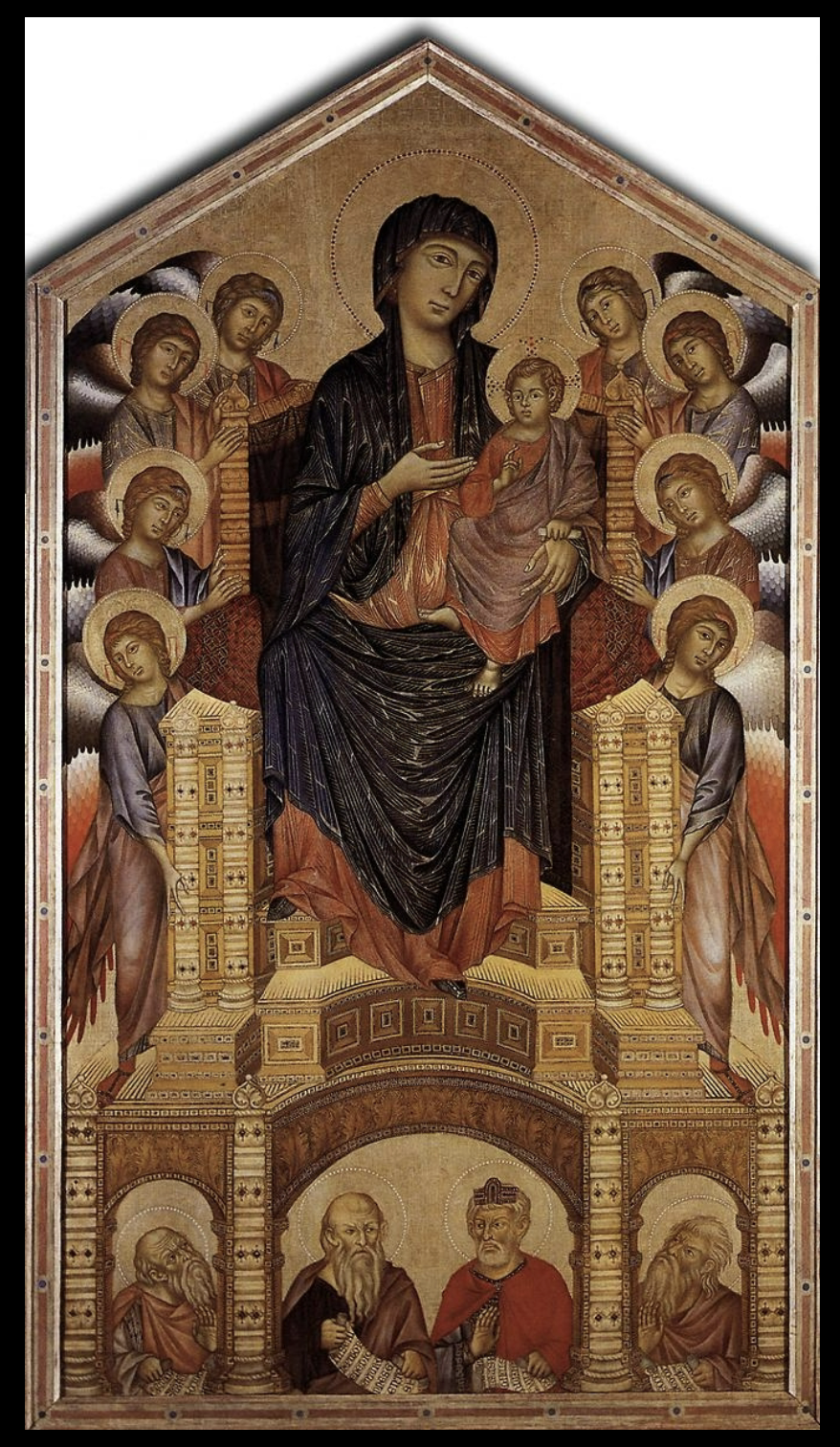
Virgin and Child Enthroned (Madonna Enthroned), Florence, 1280, Cimabue
Altarpiece, tempera painting, traditional depiction the Virgin and the Christ Child
Includes 8 angels to the side and the 4 prophets below
The usage of gold flattens out the painting, emphasizing the scene and the characters’ presence in the Heavenly realm.
Italo-Byzantine style with hierarchical scale, stylized figures and heavy use of gold to create a sense of the heavenly realm.
Served as a model for later versions/interpretations
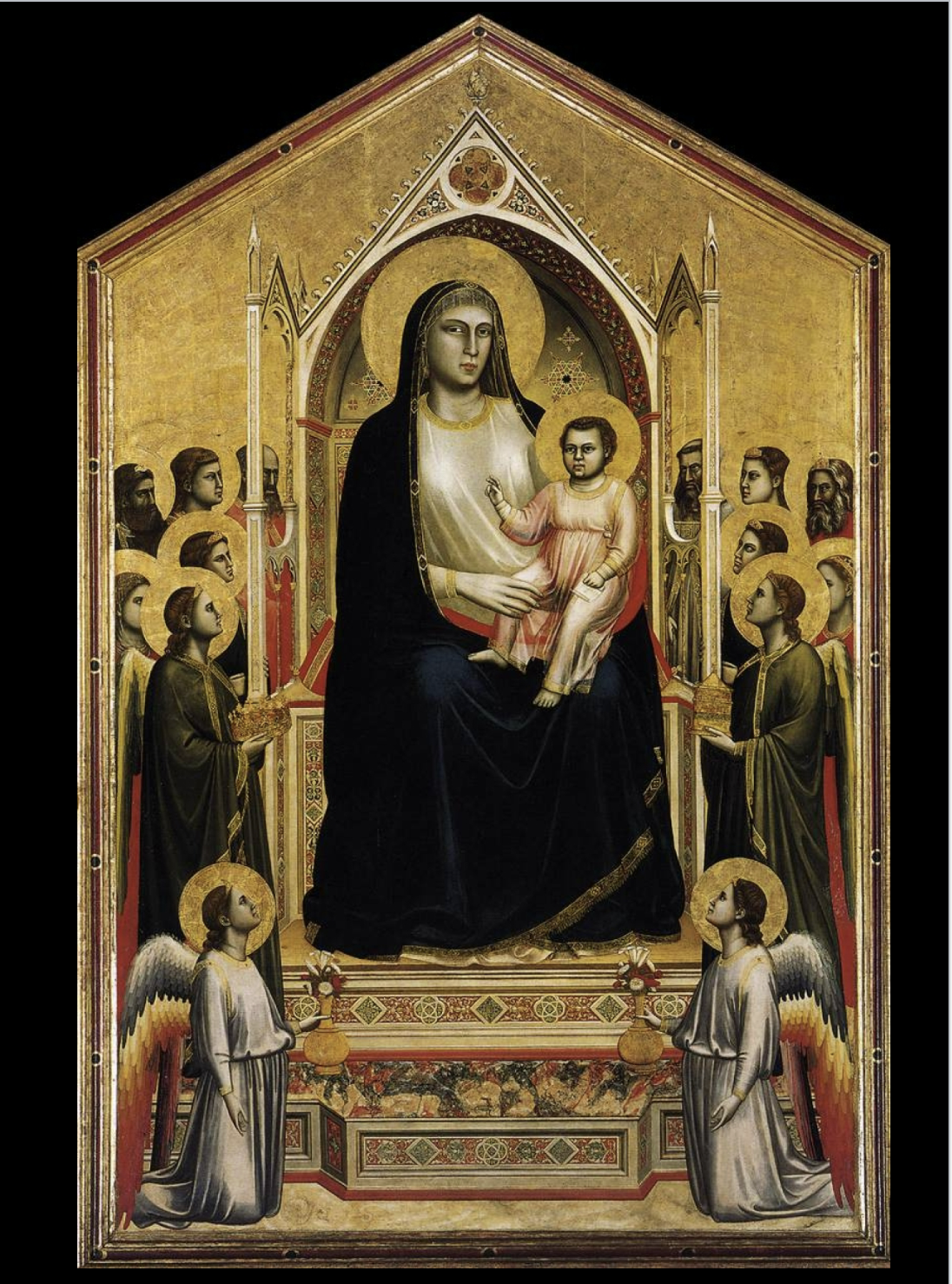
Virgin and Child Enthroned (Madonna Enthroned), Florence, 1310, Giotto
Altarpiece, tempera painting, Giotto’s interpretation of Cimabue’s 1280 painting.
Giotto incorporates a clear sense of space by defining a light source and showing the heavenly figures in a more human way. The angels and other figures are layered as they would be if seen in real life, not floating like in Cimabue’s. The sense of space is re-emphasized by the background figures interacting with the throne and how some can be seen through the windows in the throne.
There is also a clear presence of gravity, seen in the fabric of the kneeling figures, as well as the fabric of the Virgin.
Giotto also brings this scene into our world by adding the floor and steps at the bottom of the scene, allowing us as viewers to enter the scene and also worship the Virgin.
A revolution in storytelling and creating scenes with human emotion and connection
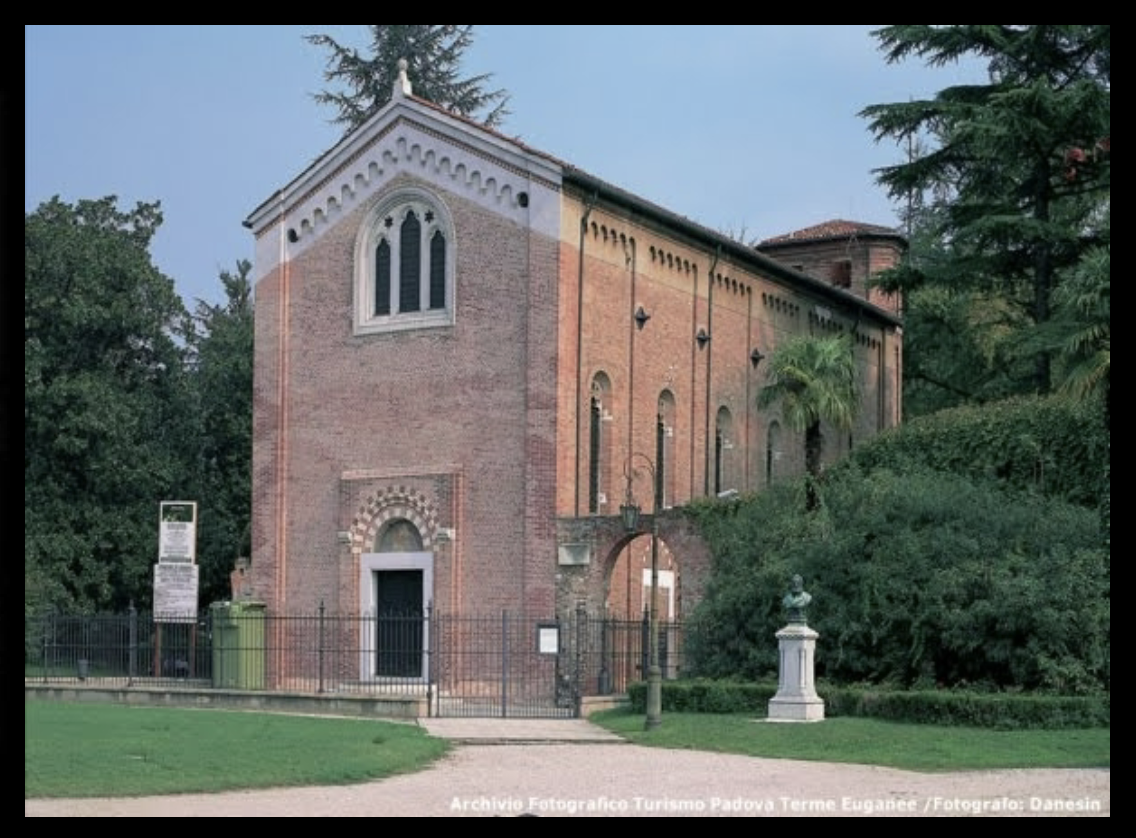
Arena Chapel (exterior), Padua, 1305-6
This is the outside of the chapel, commissioned by Enrico Scrovegni, a rich banker at the time.
Made completely out of brick
Built on the ruins of an old Roman arena, in the same likeness
was a personal chapel, which was very rare at the time, so getting permission from the church, and being able to not only build it but also decorate it from top to bottom was a large statement of Scrovegni’s wealth.
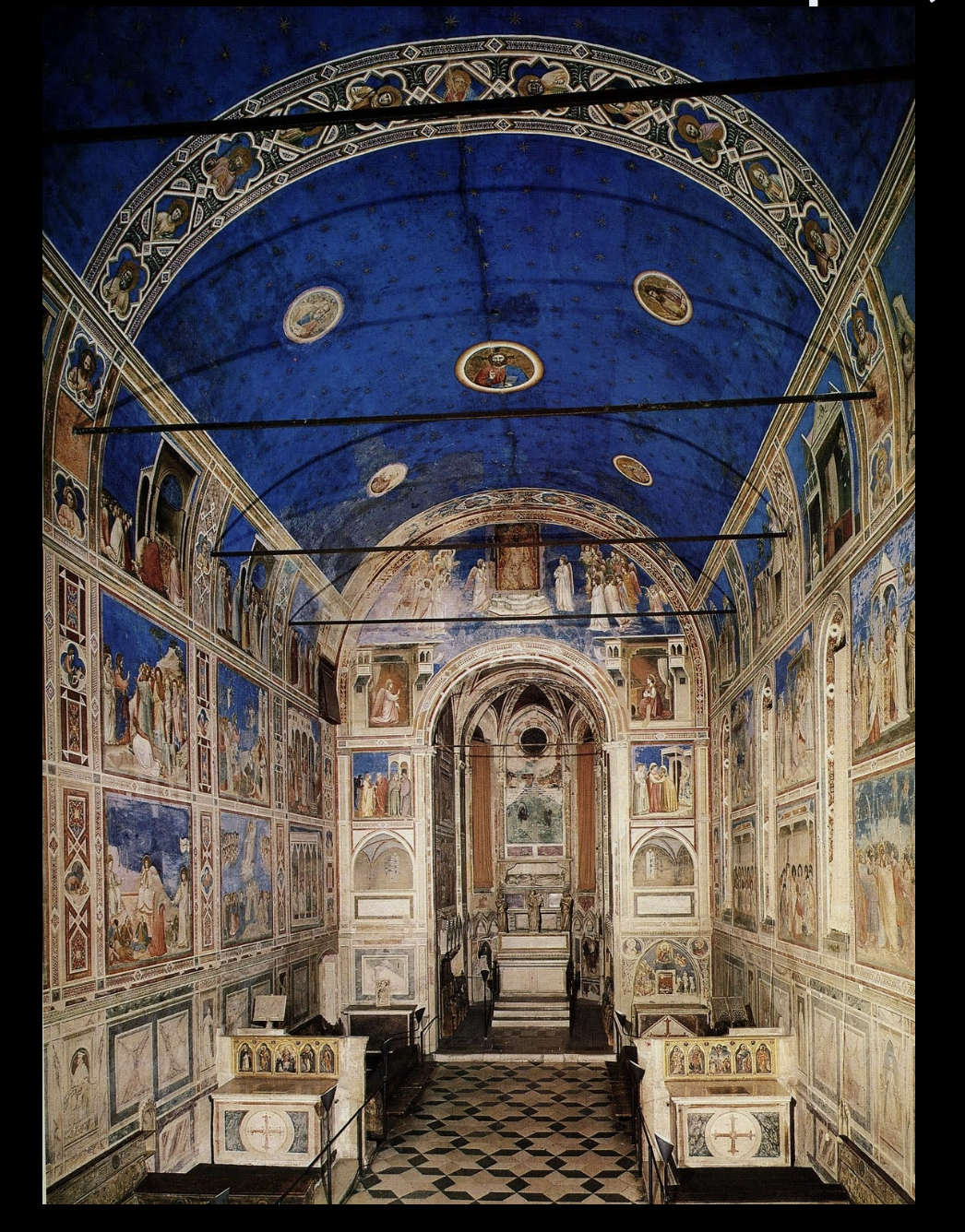
Arena Chapel (interior), Padua, 1305-6
Interior of the chapel that was commissioned by Enrico Scrovegni, and decorated by Giotto all in true fresco
The scenes of the Virgin’s life and subsequently Jesus’.
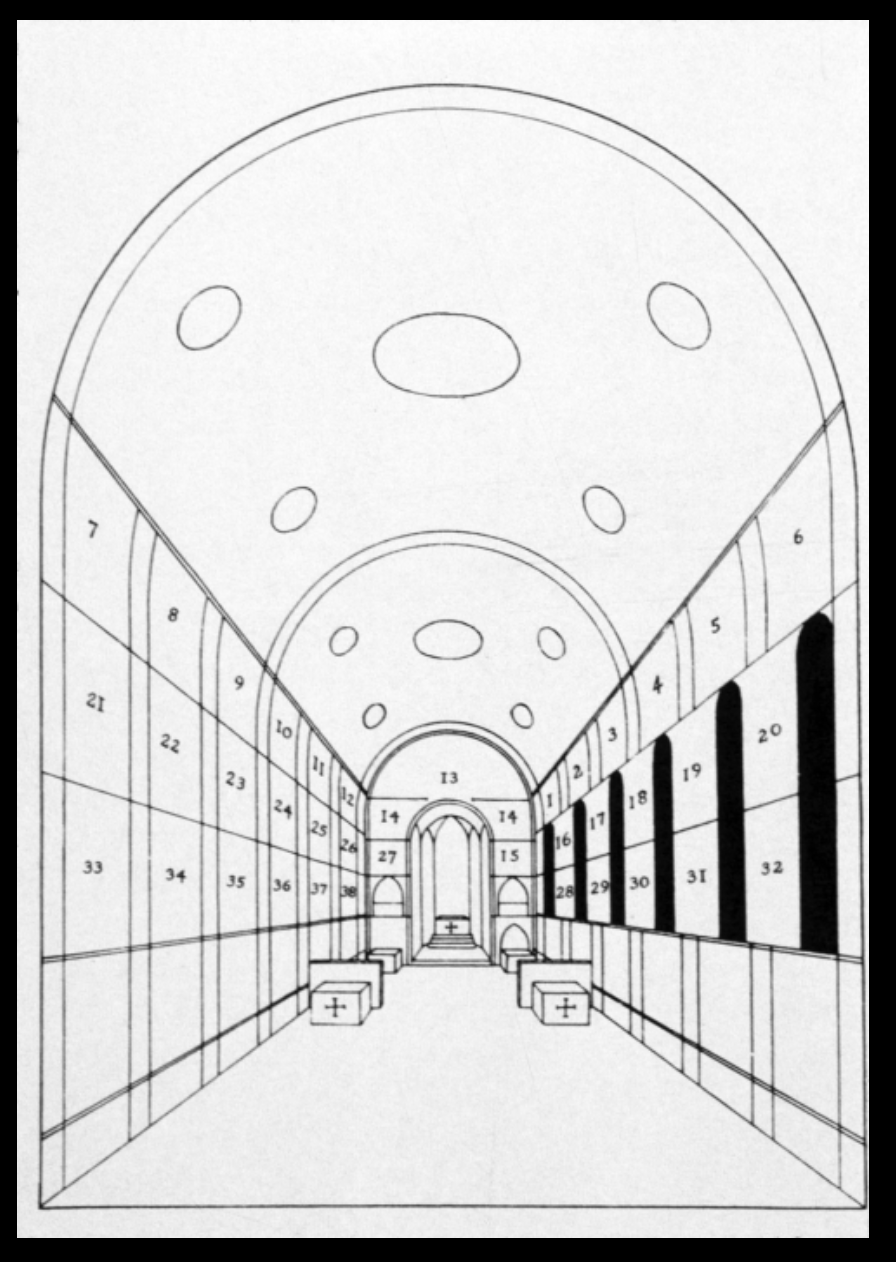
Arena Chapel (diagram), Padua, 1305-6
The scenes progress in order of scenes of different elements of the Virgin’s life, and subsequently, Jesus’s
The first 6 scenes show Mary’s parents, Johann and Anne, then the next few show Mary’s life, before finally showing the classic stories of Jesus’s life.
The scenes progress in a circular motion around the chapel, and were each about 12 × 12 ft.
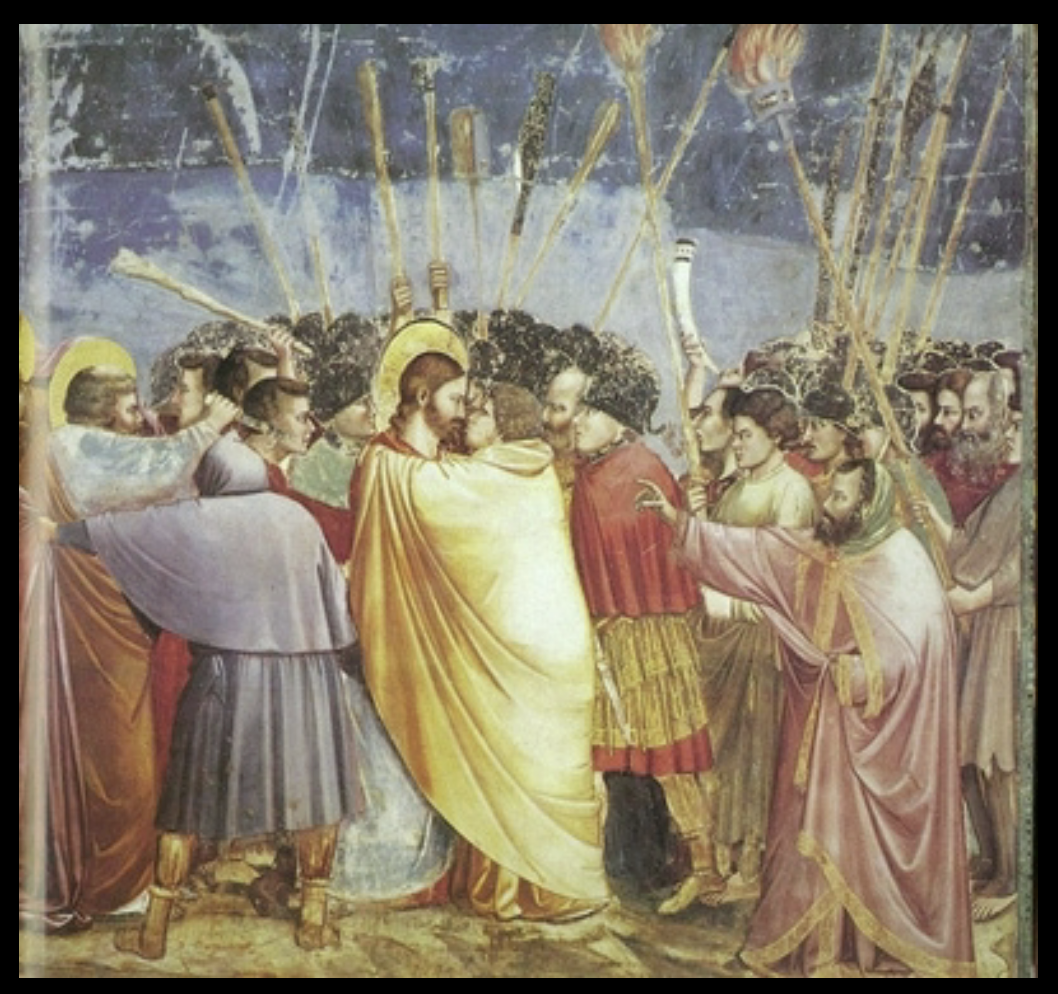
Kiss of Judas, Arena Chapel, Padua, 1305-6, Giotto
Jesus’ form is completely covered and swallowed by Judas grabbing him.
Giotto depicts Jesus and Judas in a very different way to many other traditional depictions. He has the two making intense and serious eye contact.
Showing this confrontation, Giotto emphasizes how both of them knew exactly what was happening in the moment Judas chose to betray Jesus and turn him over to the soldiers.
This type of emotion brings the scene into our world, and this interaction makes it feel more human-like
Giotto also brings this scene into our world with the blue sky (due to the common fresco technique), and by repeating the same type of receding pattern of the crowd disappearing into the distance.
He also allows the viewer to identify with the scene by having the one figure’s back turned to us.
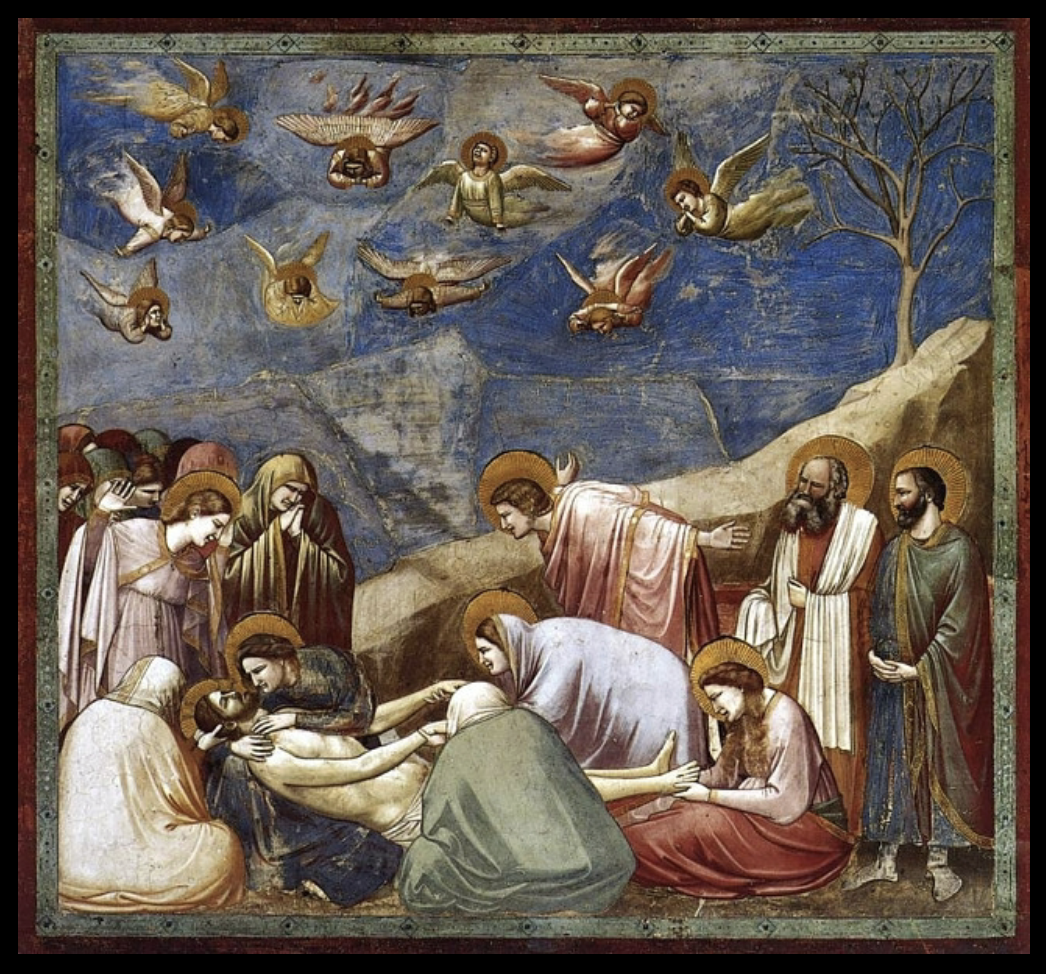
The Lamentation, Arena Chapel, Padua, 1305-6, Giotto
Giotto again shows a lot of emotion within this piece, with the connection between the Virgin and Jesus, having just passed.
He shows the other people in the picture going through a variety of emotions, which is something that had not been seen much before, other than in Giotto’s other works.
He again allows us to identify with the crowd of human figures off to the left of the image, along with the blue sky and minimal landscape in the background.
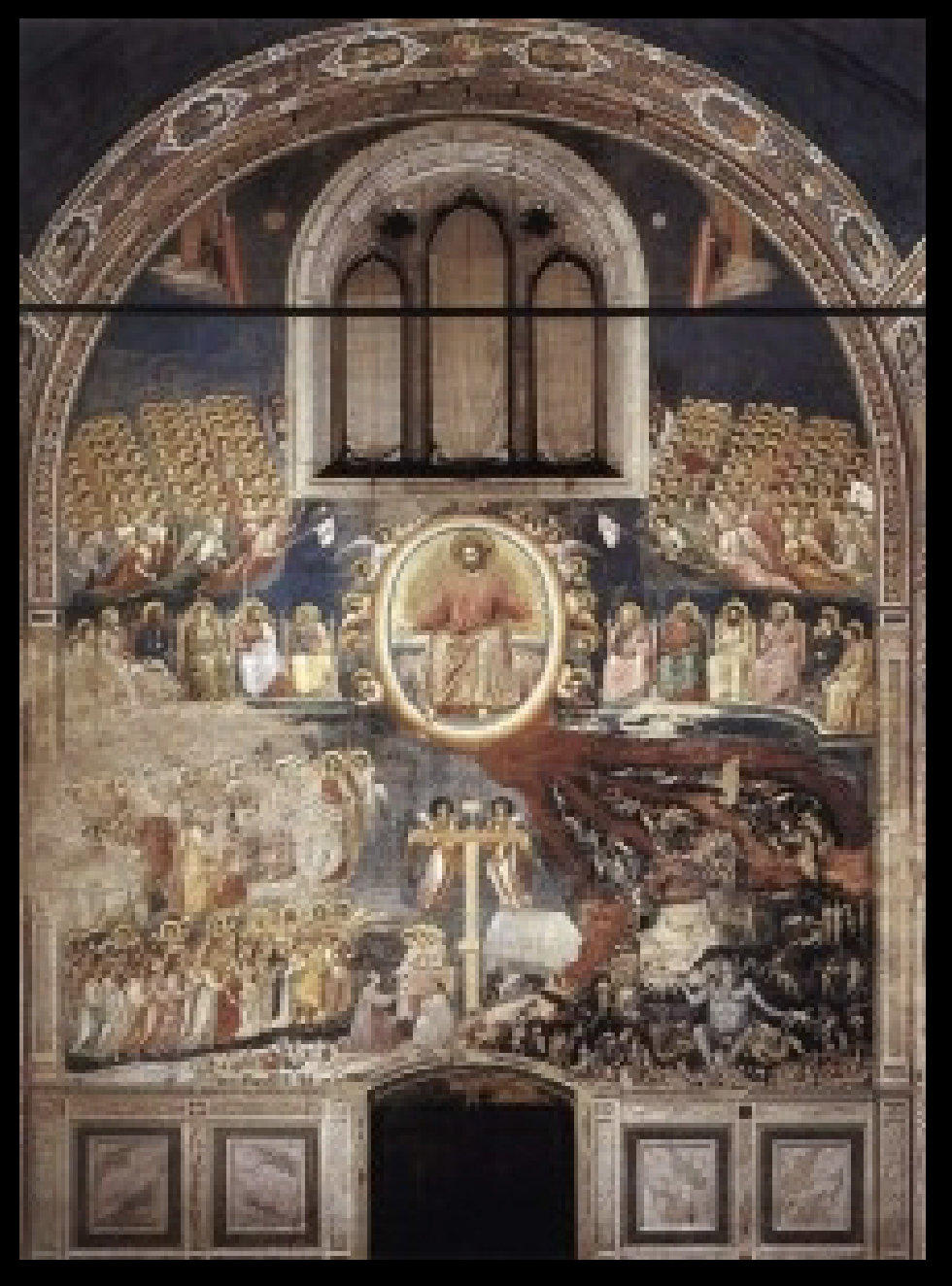
Last Judgment, Arena Chapel, Padua, 1305-6, Giotto
This was traditional in its placement and overall composition of the piece, being placed above the entrance/exit, being the last thing you see when leaving the chapel, and to remind you what’s coming and to encourage you to live a life in the image of God.
It is traditional in the way that to Jesus’ right are the saved and to the left are the damned. We see his disciples sitting beside Him in his sort of orb of light. He tilts his head towards the saved, acknowledging them.
In the scenes of the damned are the usual sorts of atrocities, and all the damned souls are depicted as naked, which was often associated with sin at that time.
In the bottom middle, we see patron Enrico Scrovegni offering the Arena Chapel to the Virgin and two other heavenly figures as an atonement for his sins of being a banker and how he had come upon his money. (Because at the time, bankers generally made their money by placing lots of interest on their loans, which was related to sinning, so they would use their money to commission works for the church in order to relieve their sins.)
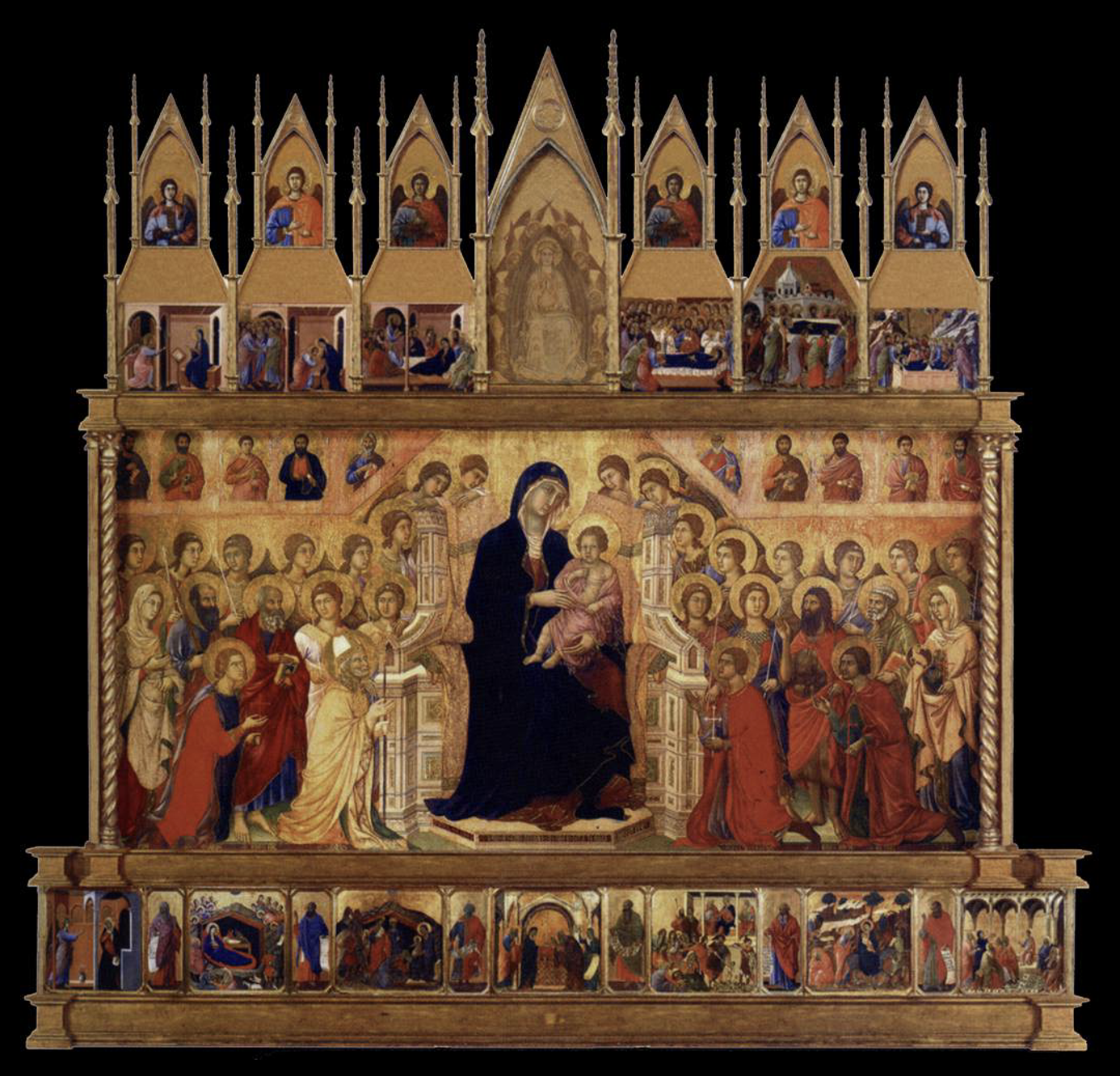
Maesta Altarpiece (front), Siena, 1308-11, Duccio
Duccio, in this, combines a variety of different art styles, Italo-Byzantine, Gothic, and French Courtly, to comprise the various figures seen in the crowds to the sides of the Virgin.
The center drawing is Duccio’s interpretation of Cimabue’s painting.
It is not fully put together due to being cut apart during the Renaissance, when everyone saw medieval art from the Middle Ages as “bad.”
Duccio’s common “mark” was his singular gold line to define fabric, seen in the Virgin’s robe/dress
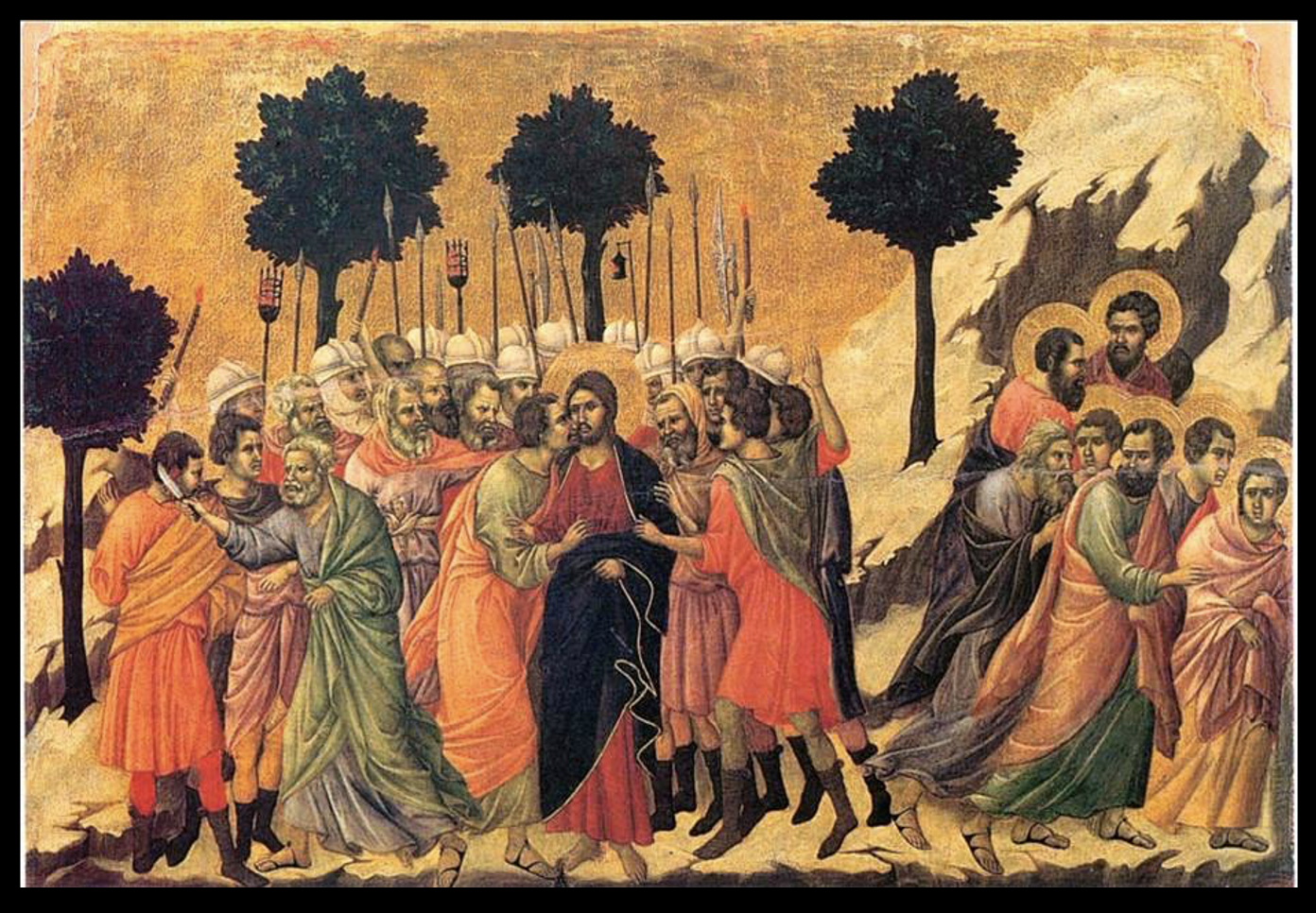
Maesta Altarpiece (back, Kiss of Judas), Siena, 1308-11, Duccio
More traditional depiction of the kiss of Judas, where Jesus is seen as facing forward with Judas kissing him on the cheek, very different from Giotto’s
Also traditional in the way that we as the viewer cannot enter the scene, due to them being on the clear edge of a cliff, of a gap that we as viewers cannot cross.
We see again the single gold line that Duccio uses to define fabric.
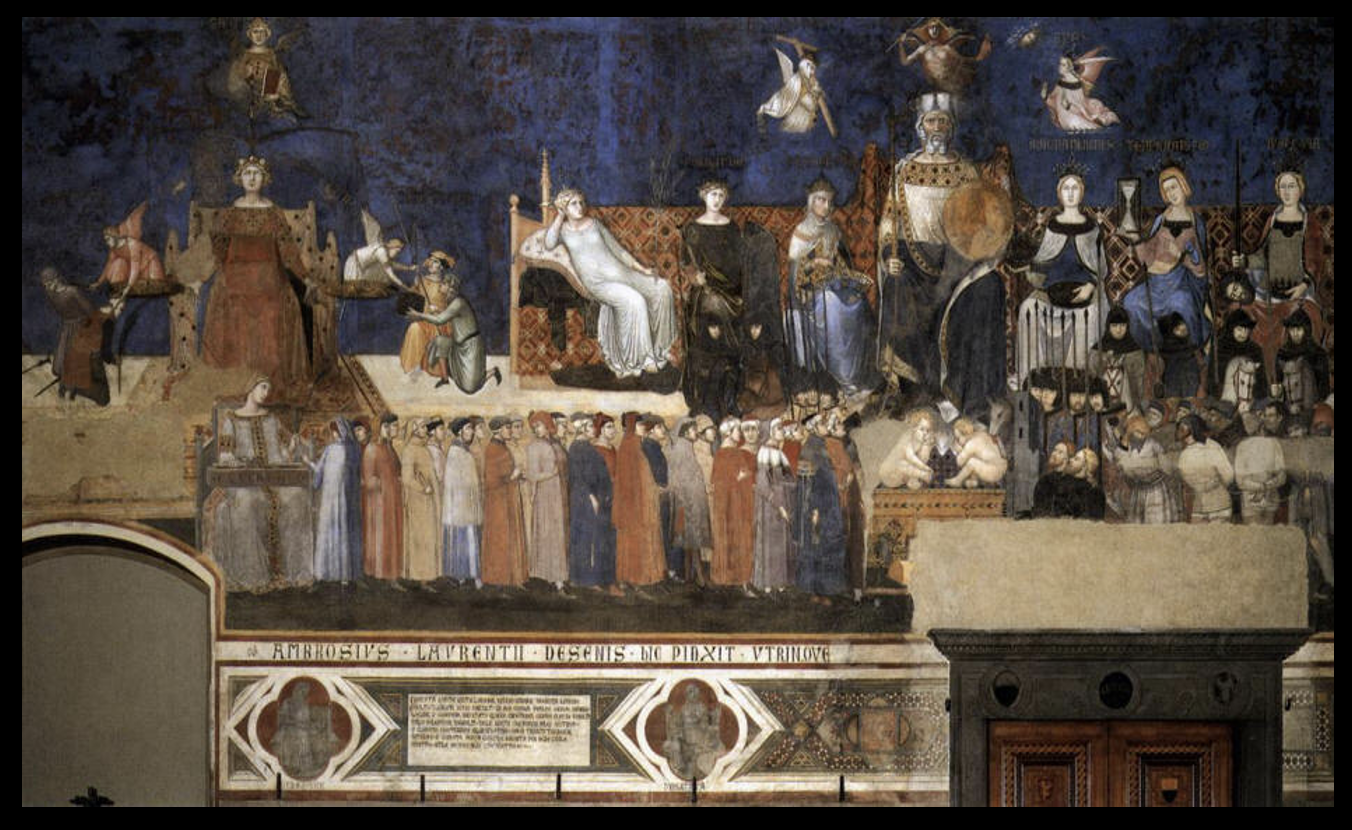
Allegory of Good and Bad Government (Good Government), Siena, 1338, Ambrogio Lorenzetti
This is a celebration in general of the ideals that a good government would have, like justice and harmony, as pictured to the left of the scene.
Above the king’s head are also virtues that a government head should have (though, this figure was not an actual government figure at the time.)
These works filled a room of city hall where officials would sit and work beneath, and be reminded of the virtues it takes to make a government good and to keep the people happy and taken care of.
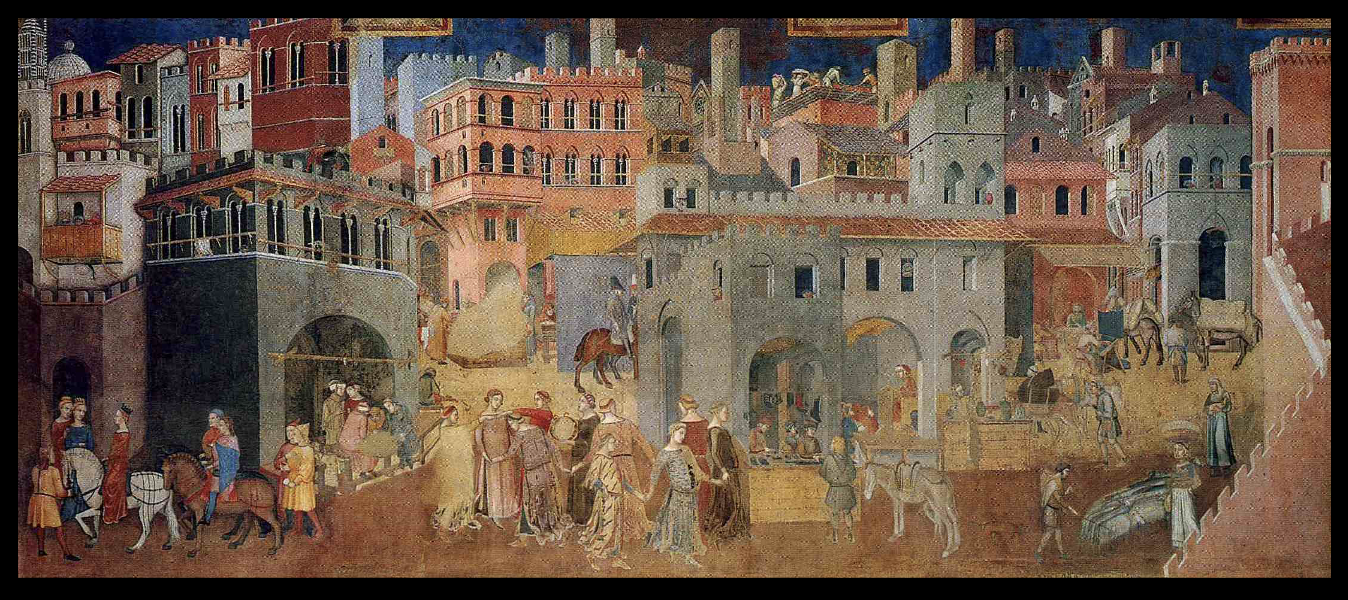
Allegory of Good and Bad Government (Good City), Siena, 1338, Ambrogio Lorenzetti
This is a depiction of what good government looks like in the city, where people are frolicking and happy, buildings are being built and updated, the gates are open, and the markets are thriving
In the top left we can see the chapel in Siena (added later than when the original piece was finished) and we also see how the people are dressed similarly to the people of Siena, telling us that this happy world and good government is in the city of Siena.
These works filled a room of city hall where officials would sit and work beneath, and be reminded of the virtues it takes to make a government good and to keep the people happy and taken care of.
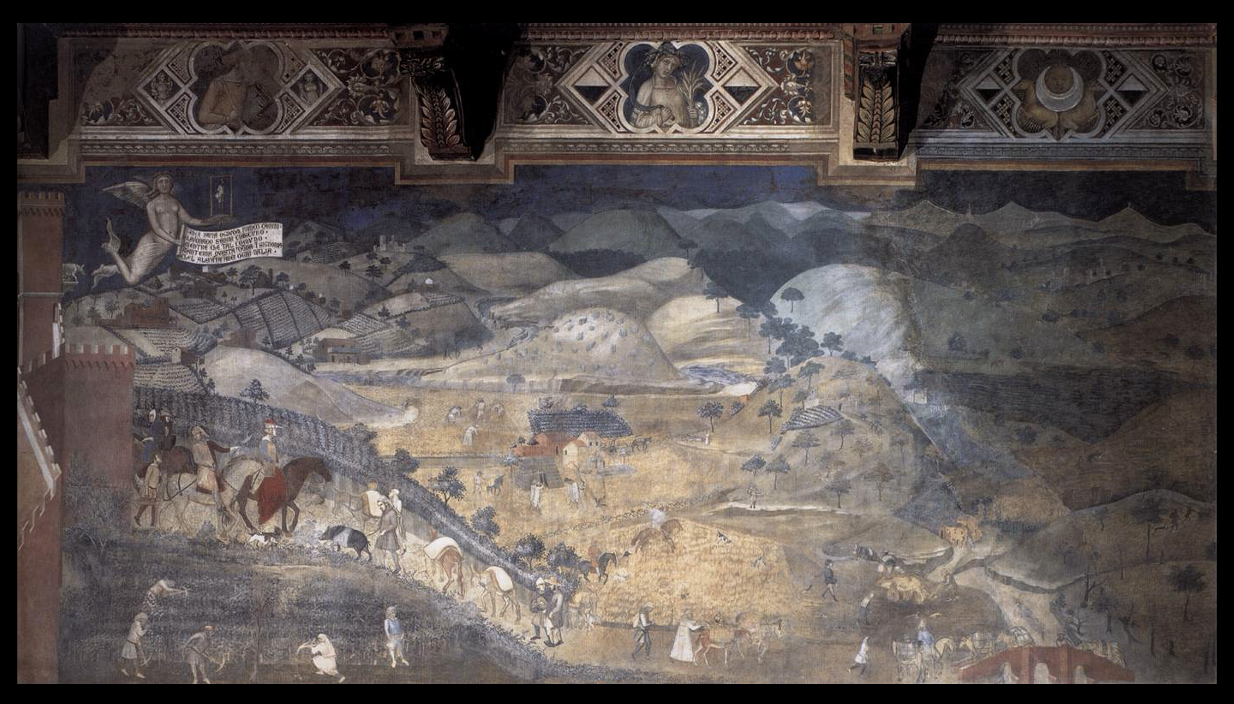
Allegory of Good and Bad Government (Good Country), Siena, 1338, Ambrogio Lorenzetti
This is a depiction of what good government looks like in the countryside. Once again, there is a lot of travel going on, and the gates are open. The crops are thriving and there is a lot of connection among the people and their villages. It is a very prosperous scene.
In the top left, the figure serves as a reminder that these happy times are not without sacrifice, and if you are to mess up the peace, you will be punished.
Once again, the landscape and the people are used as a tool to identify the scene as being in Siena, and that Siena has a good government.
These works filled a room of city hall where officials would sit and work beneath, and be reminded of the virtues it takes to make a government good and to keep the people happy and taken care of.
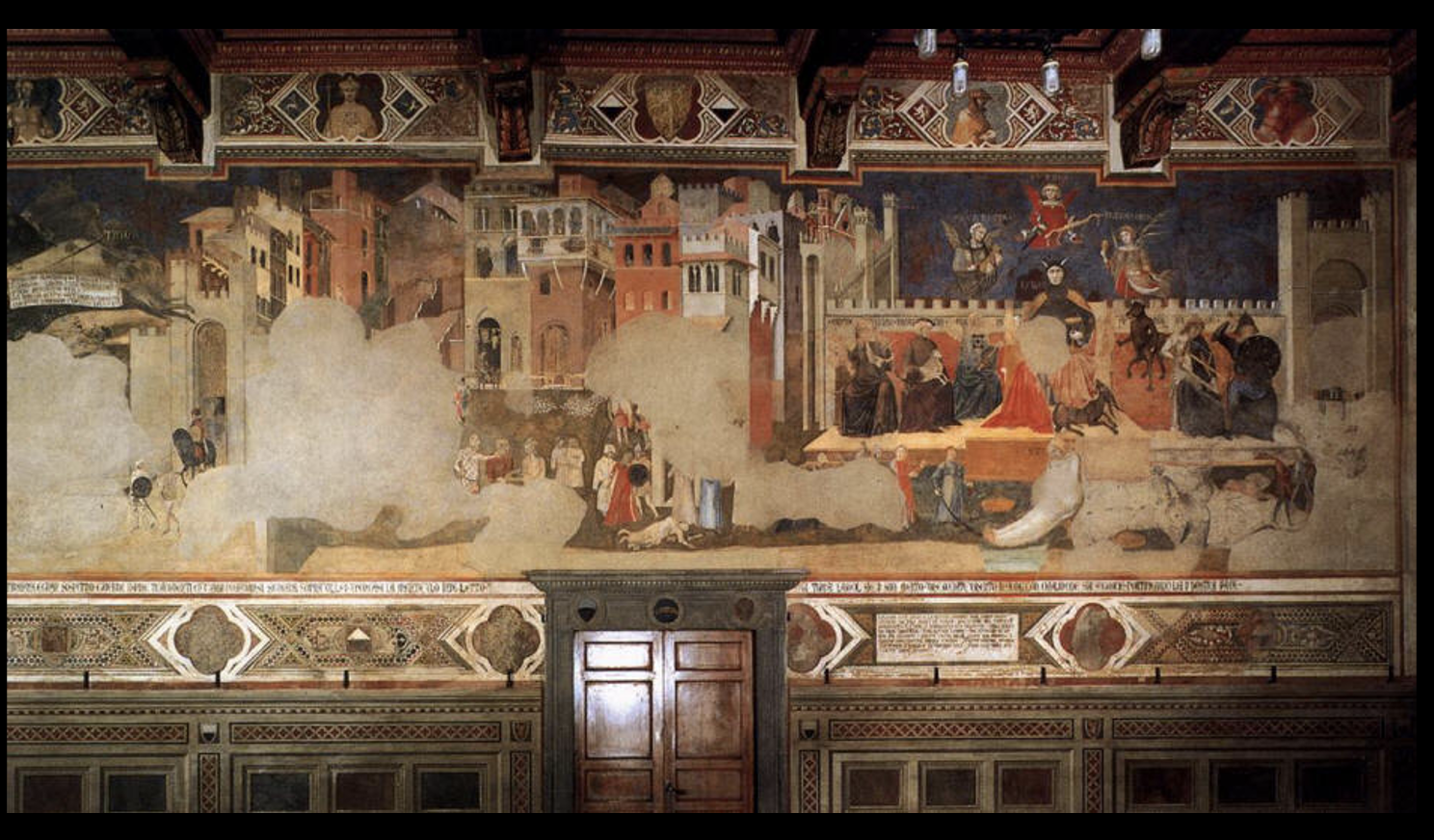
Allegory of Good and Bad Government (Bad City), Siena, 1338, Ambrogio Lorenzetti
This is a depiction of what bad government looks like in the city and in general. In the right of the image, there is a similar depiction as the Good Government celebration, but in this one we see the head of the government being illustrated as a devil, with virtues of a bad government flying around him.
From what we can see of the city, there is evidence of death, crime, destruction, and other negative connotations. We can make the connection of the broken buildings to the one in the “Good Government” painting being built/rebuilt. All elements of bad government.
The large empty parts of this scene are due to destruction, it is unknown if this was just never repaired or continually ruined as a sign of hatred towards a bad government, or if it was never repaired to re-emphasize the point of destruction that will happen with a bad government.
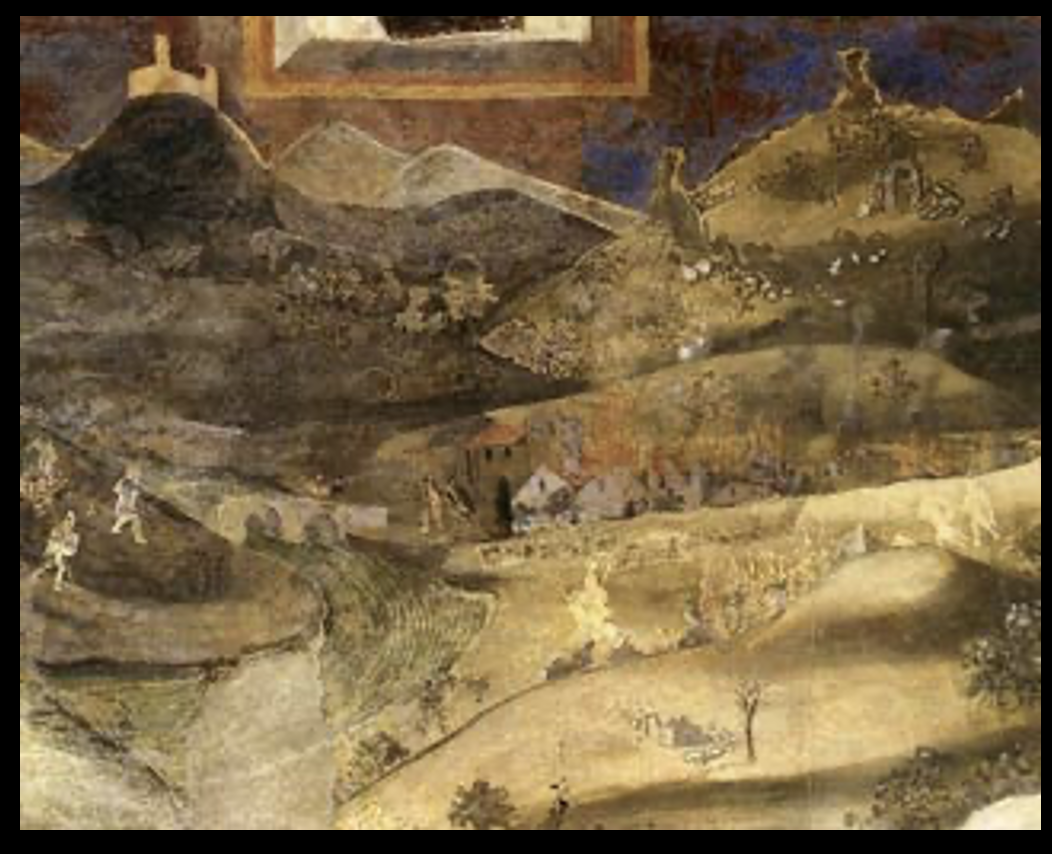
Allegory of Good and Bad Government (Bad Country), Siena, 1338, Ambrogio Lorenzetti
Here is a depiction of what bad government will do to the countryside. The villages are aflame, it is not prosperous with crops, and there are “ghosts” roaming the fields, further emphasizing the disconnection formed by bad government.
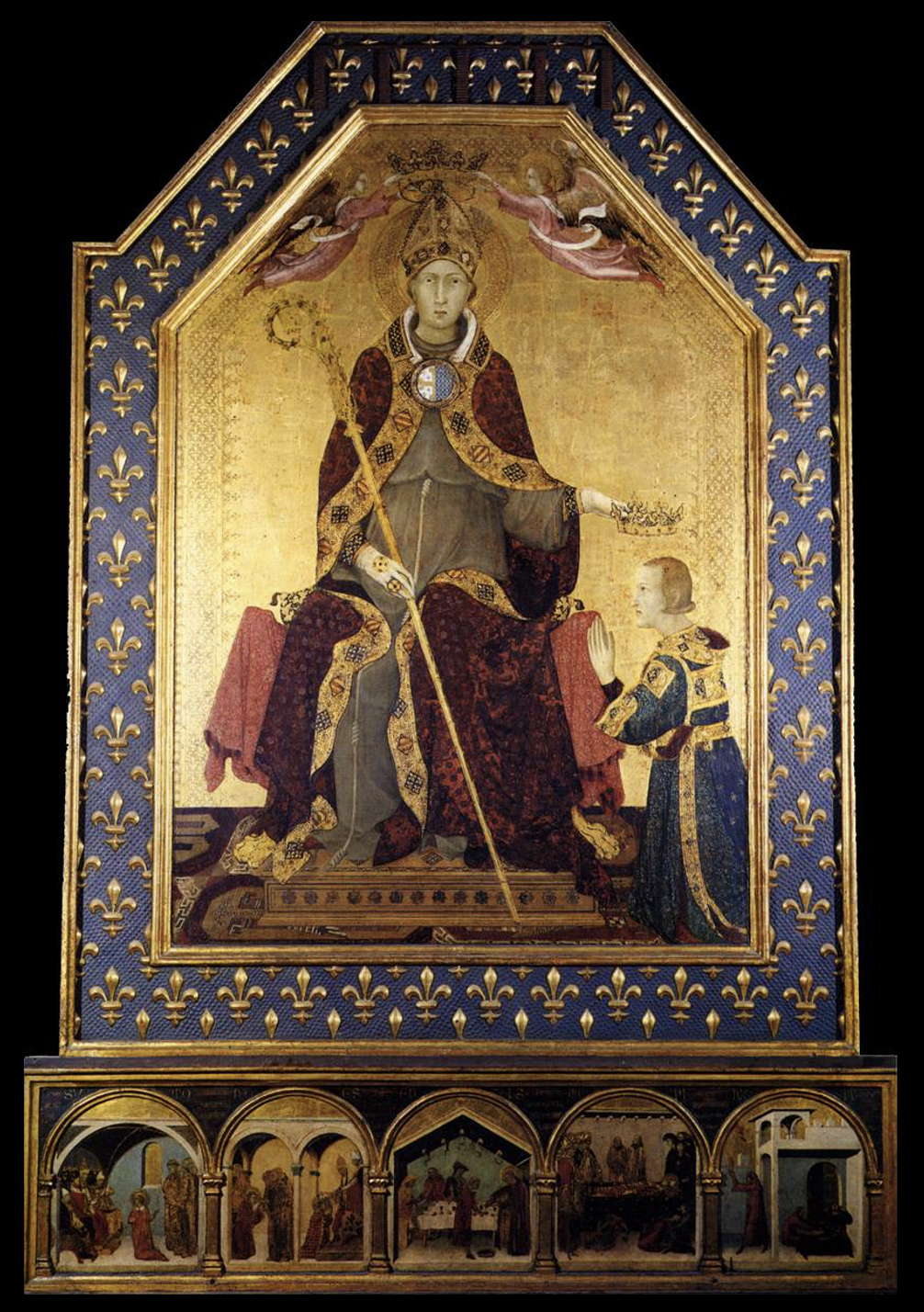
St. Louis Altarpiece, Naples, 1317, Simone Martini
This tempera painting was commissioned by Robert of Anjou, the (soon to be, if not already) King of Naples. He was the brother of the King of France.
It shows Saint Louis, a Franciscan man who was later associated with many miracles, and eventually named a saint.
This shows him being crowned as a saint, while he is also crowning Robert of Anjou “naming” him as the rightful king of Naples, which was a heated dispute at the time. Due to St Louis being the chosen saint of Naples, Robert of Anjou commissioned this as a way of asserting himself as the rightful king of Naples, also having himself shown in the traditional French colors at the time, with the border of the fleur de lis pattern, also calling back to France and it’s dominance at the time.
The beginning of what will become known as the International Gothic Style with its emphasis on courtly elegance, rich materials and sense of luxury designed to appeal to the members of aristocratic courts.